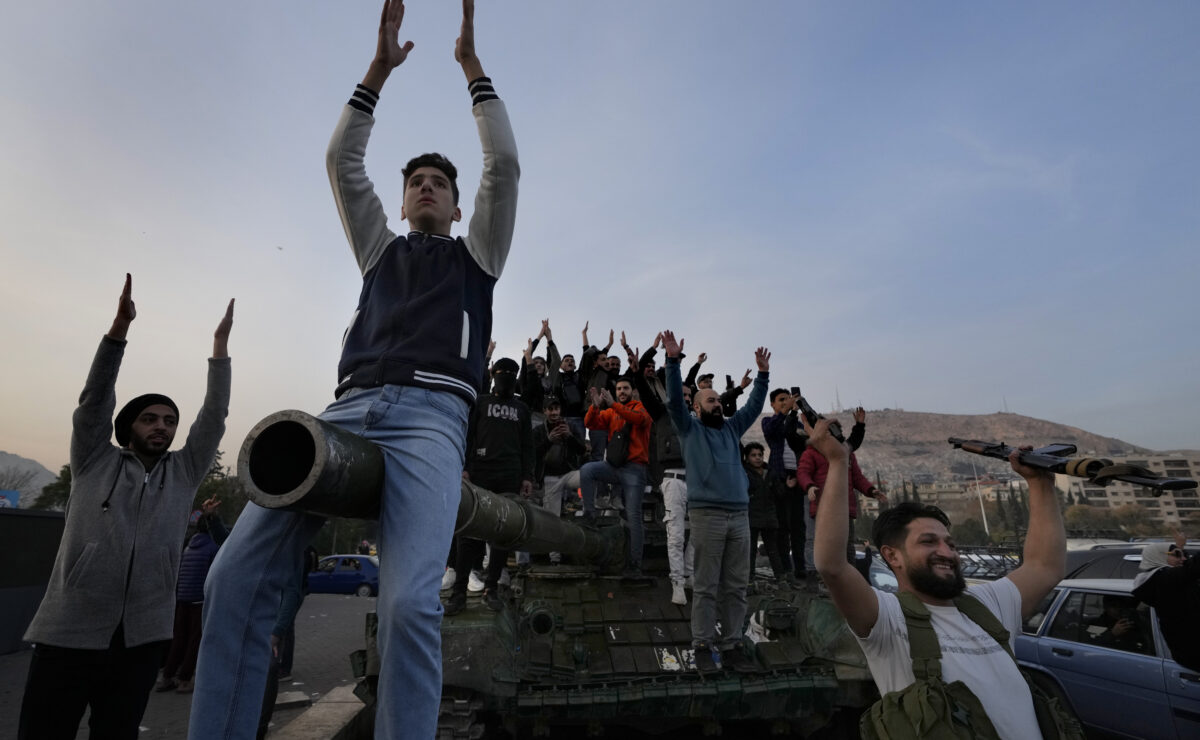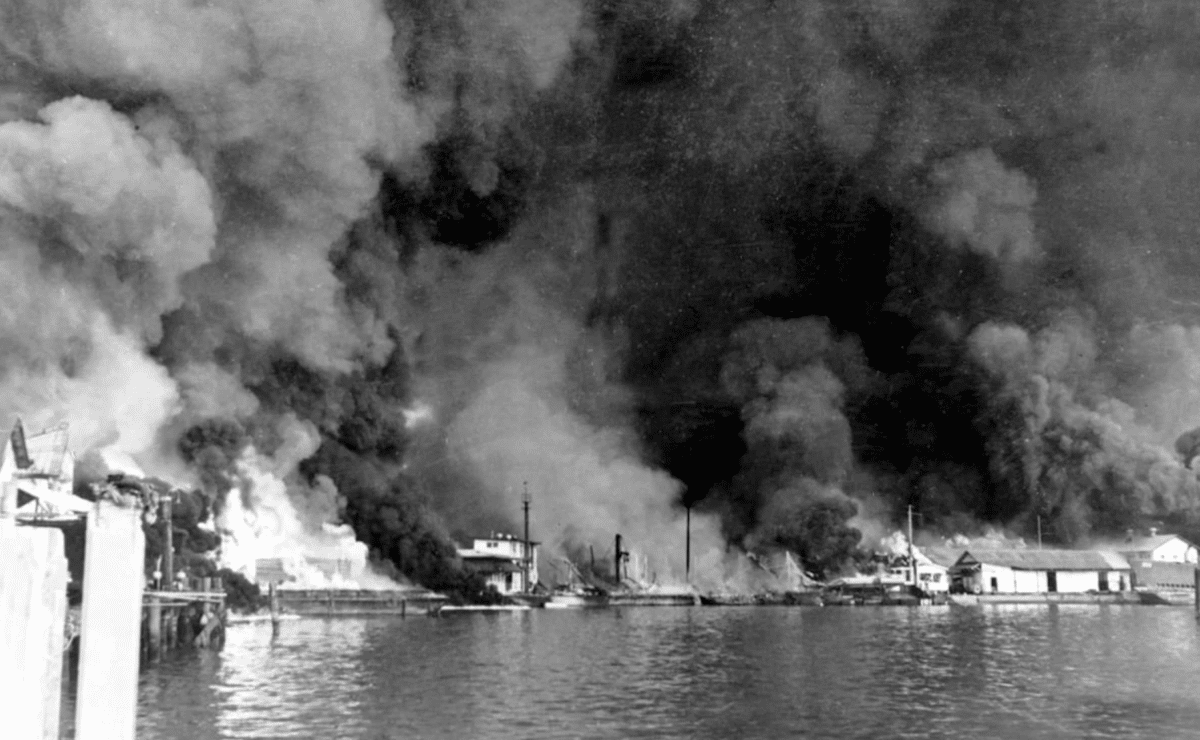Syria, Trump and Fil-Ams’ shameful Pearl Harbor history

Syrian citizens stand on a government forces tank, that was left on a street, as they are celebrating during the second day of the take over of the city by the insurgents in Damascus, Syria, Monday, Dec. 9, 2024. (AP Photo/Hussein Malla)
If you thought the only surprise this past weekend was how Buffalo’s Josh Allen could play so brilliantly and lose to the Los Angeles Rams, well it was a weekend of surprises.
Big surprises.
Remember, it was also the historic weekend commemorating Pearl Harbor. And I bet you didn’t hear more than a peep about it 83 years later?
Does the day still not live in infamy?
It does, and later in this column, I will tell you about how Filipinos in America reacted to Pearl Harbor (it’s also a surprise), and how it reveals a shameful reality about Asian America to this day.
But first off, I’m sure we didn’t hear much about Pearl Harbor because history was overtaken by “history in real time,” also known as the news.
We’re living in it.
Syrian dictator ousted
The dictator Bashar al-Assad was run out of Syria and sought exile in Russia this weekend. In just about two weeks, a coalition of rebels applied enough pressure to end a family regime that lasted 50 years.
It was a wealthy family dictatorship that plundered the country and ruled in terror. The family lived in splendor while the people languished.
That should sound familiar to Filipinos.
The end was different from Filipino People Power which was peaceful and chased the Marcos family to Hawaii seeking refuge from his US puppet handlers.
But as on EDSA, there was cheering in Syrian streets. Men, women and children. Christian, Muslims, different sects and ethnicities, all united against Bashar al-Asad.
The best way to describe Asad is as a genocidal narco-trafficking tyrant, whose friends were America’s biggest enemies, Iran, Hezbollah and Russia, said Mouaz Moustafa, the executive director of the Syrian Emergency Task Force, on CNN.
Moustafa said it was amazing that there would be no more Russian airstrikes, no more Asad gulags torturing civilians. “It’s
very rare in a world where we see so much war, destruction, horrible people doing horrible things. To see good triumph over evil is an amazing thing.”
You need to hear from someone like Moustafa to grasp the significance of the events of this weekend. Otherwise, you might just shrug and say, this is par for the course in the Middle East, land of forever wars.
But last weekend was different.
Consider that we are talking about Asad, the one Tulsi Gabbard consorted with and hyped to her colleagues when she was in Congress. Now Asad has been shamed and exposed, forced into exile with his puppet master Russia, and Gabbard still wants to be the US director of national security? Given her judgment on Asad, can she be trusted with our national secrets?
It’s still not over in Syria, as now there will be a scramble to see what kind of governing democracy emerges there.
Predictably, Donald Trump has said, “The United States should have nothing to do with it. This is not our fight. Let it play out.
Do not get involved.”
It’s Trumpy, nouveau isolationism.
But it sounds more like Trump speaking Russian talking points, running interference for his buddy Putin.
Compromising US interests for Putin’s is not a good look.
What’s happened in Syria has the potential of reshaping the politics of the entire Middle East. The US can’t afford to sit back and do nothing. Now is the time to exert peaceful, diplomatic influence on how Syria maintains stability and goes forward with its new democracy.
Certainly, the Filipinos in the Middle East will be impacted by what happens in Syria and the region.
Moreover, the ouster of the dictator should give Trump pause.
If by nominating loyalists like Gabbard, Pete Hegseth and Kash Patel, Trump is testing the evolution to strongman rule in the US consider what happened before last weekend.
In South Korea, a weak president tried to declare martial law and was voted down by Parliament. That’s a faux strongman.
But in Syria, Asad, a real strongman, lost bigly. Propped up by Putin and praised by Tulsi Gabbard, Asad raced home to Russia to hide with his family.
Both leaders lost out to the people in both Syria and S. Korea who wanted one thing—freedom. A strongman government doesn’t stand a chance when the people are united.
But Trump is making strongman noises. Like saying Liz Cheney and the rest of the congressional Jan. 6 committee members should be jailed.
That’s the Putin-wanna-be in Trump talking. Or is that the Marcos-wanna-be? A US strongman? Trump can be puppet and puppet master all in one.
Let’s hope Trump who has said he’d be a dictator on Day One learns a lesson from the week’s news.
Eventually, freedom wins.
Filipino Americans and Pearl Harbor
Not until a few years ago, I had never stopped to research the Asian American reaction, specifically the Filipino American reaction, to the bombing at Pearl Harbor or the internment order.
I just assumed we had the same perspective as we do now – that it was all a horrible setback to Japanese Americans and Asian Americans, in general, and that we were all in solidarity. That’s my 21st century view of us back then in 1941.
Boy, was I wrong.
First, there was no real sense of an “Asian America” back then.
We were all struggling, one Asian ethnic group at a time, from racist policies against Asians starting with the Chinese Exclusion Act.
In California, there was anything but solidarity. And when Pearl Harbor hit, there was solidarity against both the Japanese and Japanese Americans.
Ten hours after Pearl Harbor, the Japanese attacked the Philippines and laid the groundwork for a full-fledged occupation of Manila and the islands, complete with a Filipino puppet government.

The Cavite navy yard under attack in December 1941 after the bombing of Pearl Harbor. Photo from the US Naval Institute
For the 40,000 Filipinos who had come to the US since the early 1900s, primarily as American nationals, whose side would you be on?
It was a bonding moment for Chinese and Filipinos, but specifically Filipinos with whites.
In California, most notably Stockton, Pearl Harbor was a catalyst for change for the social status of Asian communities.
Bad for the Japanese. Good for the Filipinos and Chinese.
“Once seen as half-human, inferior savages, Chinese and Filipinas/os were suddenly America’s allies, while the Stockton Japanese community immediately found itself the target of racist attacks from their Asian neighbors as well as whites,” wrote the late Dawn Bohulano Mabalon, a Stanford-trained Ph.D, who was a tenured professor of history at San Francisco State University.
Her book, “Little Manila Is in the Heart,” revealed how Pearl Harbor changed the racial pecking order quickly. “Once the favored racial minorities of white elites in the Delta, ethnic Japanese found themselves under racial attack and intense scrutiny in Stockton through the winter and spring of 1941-1942.”
The reaction occurred all up and down the west coast, with Filipinos boycotting Japanese-owned businesses, moving out of rooming halls and even wearing badges that said “I am Filipino,” to make sure no one mistook them for Japanese.
More surprising were the oral histories captured by Mabalon. Camila Carido said Filipinos were prepared to arm themselves against the Japanese American community. And Carido said that she and many Filipinos were for the internment of Japanese Americans.
“Oh, lotsa Filipinos were armed, ready to kill the Japanese,” Carido told Mabalon. “Lucky thing the Japanese were sent out to the camps, otherwise there would have been lotsa Japanese just fall out and died, and nobody knows? They had bad feeling against them, especially with all the killing in the Philippines.
Lotsa Japanese here [in Stockton] they just disappear! Good thing that President Roosevelt had that idea to bring the Japanese, even if you are an American citizen, to the camp.
Otherwise, there were lotsa people killed.”
The Stockton Daily Record reported on February 20, 1941, a day after the internment announcement, at least two Japanese had been murdered mysteriously since the war began. Asian American historian Nelson Nagai also confirmed to Mabalon that several Japanese residents were killed by Filipinos after Pearl Harbor, but no one was ever arrested.
We’ve long known about the “infamy” of Pearl Harbor from a xenophobic US perspective. WE blister at the “N” word now.
But there was no “J” word back then. It was “Jap” – it was ugly, and it was everywhere, as if the bombing wasn’t enough to bring out a passionate response. Now after reading history, we see how a bit of it was also on the part of other Asian Americans, specifically Filipinos and Chinese, joined in the xenophobic reaction of whites.
Did we invent a kind of self-xenophobia?
Reading Mabalon’s book helps us appreciate what it meant to be Asian in America back then. Only when the 1965 Immigration Act lifted the racist quotas against Asians, was there a real chance for a large and expansive multi-ethnic community to develop and define a new political umbrella term, “Asian American.”
And we’re still evolving.
When the talk gets tough among us, remember Pearl Harbor, when no one had a sense of an Asian America.
We were all fighting for a place in America, but we were still separate and unequal.
Emil Guillermo is a journalist and commentator. He writes for the Inquirer.net’s US Channel. See him on www.patreon.com/emilamok or on www.YouTube.com/@emilamok1

